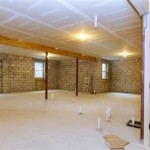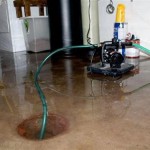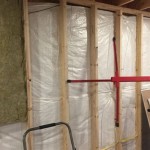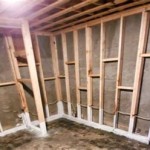How to Mitigate Moisture Intrusion in Basements
Basements, by their very nature, are prone to moisture problems. Situated underground, they are surrounded by soil that often contains significant amounts of water. This proximity, combined with the typically cooler temperatures found in basements, creates an environment conducive to condensation and water intrusion. Addressing basement moisture is crucial for maintaining the structural integrity of the building, preventing mold growth, and ensuring a healthy living environment.
Understanding the sources of basement moisture is the first step toward effective mitigation. Moisture can enter a basement through various pathways, including groundwater seepage, surface water runoff, condensation, and even plumbing leaks. Accurately identifying the source allows for the implementation of targeted solutions, maximizing their effectiveness and minimizing unnecessary expense.
Furthermore, neglecting basement moisture issues can lead to a cascade of problems. Mold growth, a common consequence, can trigger allergic reactions and respiratory problems. Structural damage to the foundation and framing can occur as wood rots and concrete deteriorates. Additionally, increased humidity levels can attract pests and create an uncomfortable living or storage space. Therefore, proactive moisture control is essential for maintaining a healthy and structurally sound home.
Controlling Exterior Water Sources
One of the most effective strategies for preventing basement moisture involves managing water sources outside the home. This focuses on diverting water away from the foundation and reducing the amount of water that can saturate the surrounding soil. Proper grading, functional gutters and downspouts, and strategic landscaping are key components of this approach.
Grading refers to the slope of the ground around the foundation. Ideally, the ground should slope away from the house at a rate of at least six inches over the first ten feet. This slope ensures that rainwater and snowmelt flow away from the foundation, preventing it from pooling and seeping into the basement. Addressing negative grading, where the ground slopes toward the house, is a critical first step in moisture control.
Gutters and downspouts play a vital role in collecting rainwater from the roof and channeling it away from the foundation. Regularly cleaning gutters to remove leaves and debris is essential for their proper functioning. Downspouts should extend far enough from the foundation to discharge water away from the walls. Downspout extensions, also known as splash blocks, are inexpensive and effective tools for achieving this. Consider extending downspouts at least four feet away from the foundation.
Landscaping can also contribute to moisture control. Avoid planting shrubs and plants too close to the foundation, as they can trap moisture and create a humid microclimate. Choose plants that are appropriate for the soil type and drainage conditions. Consider using gravel or other permeable materials around the foundation to allow for better drainage. French drains, installed underground to collect and redirect water, can be a more extensive solution for areas with persistent drainage problems.
Addressing Interior Moisture Sources
While exterior water management is crucial, it is also important to address potential sources of moisture within the basement itself. Condensation, plumbing leaks, and inadequate ventilation can all contribute to basement humidity and moisture problems. Implementing strategies to control these internal sources is essential for a comprehensive moisture control plan.
Condensation occurs when warm, moist air comes into contact with cool surfaces. Basement walls and floors, which are typically cooler than the surrounding air, are prime locations for condensation. Improving insulation can help to reduce the temperature difference between the air and the surfaces, thereby minimizing condensation. Insulating basement walls and floors can significantly reduce condensation problems.
Plumbing leaks, even small ones, can introduce significant amounts of moisture into the basement. Regularly inspect plumbing fixtures, pipes, and appliances for leaks. Repair any leaks promptly to prevent water damage and mold growth. Consider installing a water leak detection system to alert you to leaks before they cause significant damage. A dehumidifier can also assist with water condensation in the basement.
Adequate ventilation is essential for removing excess moisture from the basement air. Opening windows when weather permits can help to improve ventilation. However, in humid climates, this may exacerbate the problem by introducing more moist air. Installing exhaust fans in bathrooms and laundry areas can help to remove moisture generated by showering and washing. A dehumidifier is the most effective way to remove moisture from the basement air, especially in humid climates.
Implementing Waterproofing Strategies
For basements with persistent moisture problems, waterproofing may be necessary. Waterproofing involves creating a barrier to prevent water from entering the basement through the walls and floor. There are several different waterproofing methods available, each with its own advantages and disadvantages. Interior sealants, exterior waterproofing membranes, and drainage systems are common waterproofing strategies.
Interior sealants are applied to the interior walls and floors of the basement to create a waterproof barrier. These sealants are typically made of concrete or epoxy-based materials. While relatively inexpensive and easy to apply, these sealants only address the symptoms of water intrusion and do not prevent water from penetrating the foundation. Hydrostatic pressure can still build up behind the sealant, potentially leading to cracking and peeling over time.
Exterior waterproofing membranes are applied to the exterior of the foundation walls to create a more robust waterproof barrier. This method involves excavating around the foundation, applying the membrane, and backfilling the excavation. While more expensive and labor-intensive than interior sealants, exterior waterproofing membranes provide a more effective and long-lasting solution. They prevent water from entering the foundation in the first place, eliminating the buildup of hydrostatic pressure.
Drainage systems, such as French drains and sump pumps, are designed to collect and remove water from around the foundation. French drains are perforated pipes installed underground to collect groundwater and redirect it away from the foundation. Sump pumps are used to pump water out of a sump pit, which is a collection point for groundwater. These systems are often used in conjunction with exterior waterproofing membranes to provide comprehensive water management. A proper drainage system ensures that water cannot accumulate around the foundation, preventing it from seeping into the basement.
Choosing the appropriate waterproofing method depends on the severity of the moisture problem, the soil conditions, and the budget. Consulting with a qualified waterproofing contractor is recommended to assess the situation and determine the best course of action. A professional contractor can identify the sources of moisture, evaluate the structural integrity of the foundation, and recommend the most effective and cost-efficient waterproofing solution.
In conclusion, managing basement moisture requires a multi-faceted approach that addresses both external and internal sources of water intrusion. Implementing proper grading, maintaining functional gutters and downspouts, and strategically landscaping can help to divert water away from the foundation. Addressing interior sources of moisture through improved insulation, leak detection and repair, and adequate ventilation can further reduce humidity levels. For basements with persistent moisture problems, waterproofing strategies such as interior sealants, exterior waterproofing membranes, and drainage systems may be necessary. By implementing these strategies, homeowners can effectively mitigate moisture intrusion in basements, protecting their homes from damage and maintaining a healthy living environment.

Moisture In Basements Causes And Solutions Umn Extension

6 Causes Of Basement Moisture How To Fix Them

3 Ways To Prevent Humidity In A Basement Wikihow

Moisture In Basements Causes And Solutions Umn Extension

Moisture In Basements Causes And Solutions Umn Extension

Moisture In The Basement Don T Let It Linger Evergreen Midcoast Me

How To Get Rid Of Humidity In A Basement Without Dehumidifier

How To Dry A Wet Basement Bob Vila

Q A Drying Out Water Damaged Basement Addressing Issues

Have A Hot And Humid Basement Jes Foundation Repair
Related Posts







